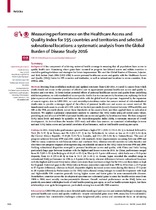| dc.contributor.author | Igumbor, Ehimario Uche | |
| dc.contributor.author | Lozano, Rafael | |
| dc.contributor.author | Fullman, Nancy | |
| dc.date.accessioned | 2019-07-29T13:36:32Z | |
| dc.date.available | 2019-07-29T13:36:32Z | |
| dc.date.issued | 2018 | |
| dc.identifier.citation | Fullman, N., Yearwood, J., Abay, S., Abbafati, C., Abd-Allah, F., & Abdela, J. et al. (2018). Measuring performance on the Healthcare Access and Quality Index for 195 countries and territories and selected subnational locations: a systematic analysis from the Global Burden of Disease Study 2016. The Lancet, 391(10136), 2236-2271. doi: 10.1016/s0140-6736(18)30994-2 | en_US |
| dc.identifier.issn | 0140-6736 | |
| dc.identifier.uri | https://doi.org/10.1016/S0140-6736(18)30994-2 | |
| dc.identifier.uri | http://hdl.handle.net/10566/4754 | |
| dc.description.abstract | Background: A key component of achieving universal health coverage is ensuring that all populations have access to
quality health care. Examining where gains have occurred or progress has faltered across and within countries is
crucial to guiding decisions and strategies for future improvement. We used the Global Burden of Diseases, Injuries,
and Risk Factors Study 2016 (GBD 2016) to assess personal health-care access and quality with the Healthcare Access
and Quality (HAQ) Index for 195 countries and territories, as well as subnational locations in seven countries, from
1990 to 2016.
Methods: Drawing from established methods and updated estimates from GBD 2016, we used 32 causes from which
death should not occur in the presence of effective care to approximate personal health-care access and quality by
location and over time. To better isolate potential effects of personal health-care access and quality from underlying
risk factor patterns, we risk-standardised cause-specific deaths due to non-cancers by location-year, replacing the local
joint exposure of environmental and behavioural risks with the global level of exposure. Supported by the expansion
of cancer registry data in GBD 2016, we used mortality-to-incidence ratios for cancers instead of risk-standardised
death rates to provide a stronger signal of the effects of personal health care and access on cancer survival. We
transformed each cause to a scale of 0–100, with 0 as the first percentile (worst) observed between 1990 and 2016, and
100 as the 99th percentile (best); we set these thresholds at the country level, and then applied them to subnational
locations. We applied a principal components analysis to construct the HAQ Index using all scaled cause values,
providing an overall score of 0–100 of personal health-care access and quality by location over time. We then compared
HAQ Index levels and trends by quintiles on the Socio-demographic Index (SDI), a summary measure of overall
development. As derived from the broader GBD study and other data sources, we examined relationships between
national HAQ Index scores and potential correlates of performance, such as total health spending per capita. | en_US |
| dc.language.iso | en | en_US |
| dc.publisher | Elsevier | en_US |
| dc.subject | Global Burden of Disease Study 2016 | en_US |
| dc.subject | Healthcare Access and Quality Index | en_US |
| dc.subject | Universal health coverage | en_US |
| dc.subject | Health-care access | en_US |
| dc.subject | Health-care quality | en_US |
| dc.title | Measuring performance on the Healthcare Access and Quality Index for 195 countries and territories and selected subnational locations: a systematic analysis from the Global Burden of Disease Study 2016 | en_US |
| dc.type | Article | en_US |

